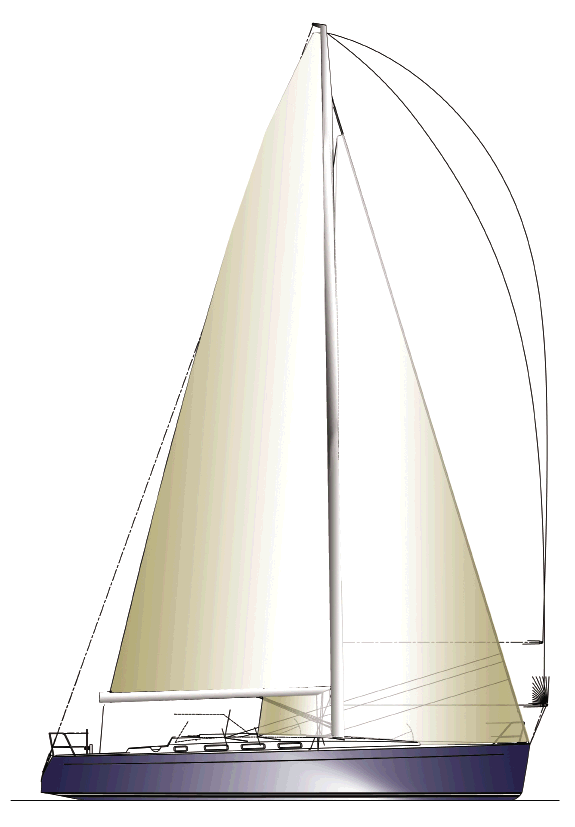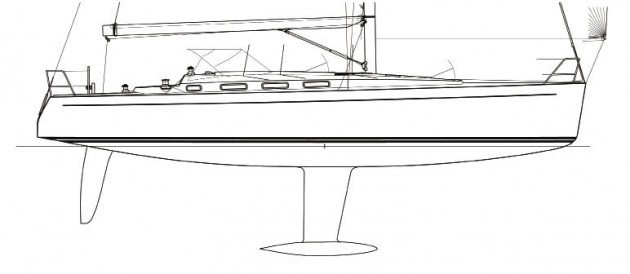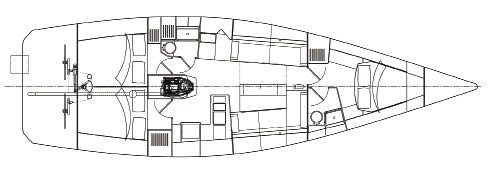Finngulf 43
2008 February 5
February 2008
Racer-cruiser
Here is a new boat from Finngulf intended to fit into the company's line of performance yacht models. Design credit is shared between the Bruce Farr office, Finngulf's in-house team and Studio Suppanen. I am attracted to this design for the same reason I like the Delphia 33, it appears slightly different from the pack of similar-sized production boats today.
I would suspect that this boat is designed to race in the IRC class, so it's not particularly light with a D/L of 148.6. The L/B is 3.23 and I'd consider this textbook medium beamy and very typical of IRC designs. The stern is broad but the sectional shape at the transom shows a very hard turn to the bilge. It's not a chine but it approaches a chine. So, when the Finngulf is pressed on the wind it probably will immerse a portion of the transom but due to the sectional shape the immersed portion will be very small. Looking at the profile of the hull I see the hull is slightly flattened near the keel and I would assume this is done to reduce hull volume to compensate for the volume of the keel and bulb so a curve of immersed areas would not show a bump in way of the keel. You see this on most Farr designs today.
Note that the rudder shows a slight kink to the leading edge right at the top. This may be done to increase rudder chord where the rudderstock needs to be the thickest. You can do it without the kink but reducing the chord would increase the thickness ratio of the foil at that point. Do you remember those old C&C "scimitar" rudders? Their foil at the top looked like a football, i.e. not effective and certainly not fast. This design comes in two models, racing and cruising. If you get the racing version your ballast is 8,287 pounds on an 8-foot, 7-inch draft keel. The cruising version has 8,752 pounds of lead on a 7-foot, 2-inch keel. More draft means the same stability with less ballast.
 The interior and overall styling credit is given to the Suppanen office. It's a good, practical layout with no surprises except for the fact that for a racing boat it is very comfortable below. The promotional material says the racing version interior is "lighter, contemporary and more airy" but it does not say the layout itself is different. There is a nice owner's stateroom forward with its own head and large hanging locker. The saloon is pretty much symmetric with a short leg on the starboard settee. Galley and nav areas look fine. There is another head aft to port. There are mirror-image quarter staterooms with double berths. Three couples could be quite comfy cruising this boat. The 40-horsepower engine with a saildrive is located right under the companionway and access looks very good. I'm not sure what the drawing is showing under the drop-leaf dining table but I suspect it is house batteries right over the keel with a starting battery under the nav seat.
The interior and overall styling credit is given to the Suppanen office. It's a good, practical layout with no surprises except for the fact that for a racing boat it is very comfortable below. The promotional material says the racing version interior is "lighter, contemporary and more airy" but it does not say the layout itself is different. There is a nice owner's stateroom forward with its own head and large hanging locker. The saloon is pretty much symmetric with a short leg on the starboard settee. Galley and nav areas look fine. There is another head aft to port. There are mirror-image quarter staterooms with double berths. Three couples could be quite comfy cruising this boat. The 40-horsepower engine with a saildrive is located right under the companionway and access looks very good. I'm not sure what the drawing is showing under the drop-leaf dining table but I suspect it is house batteries right over the keel with a starting battery under the nav seat.
 This is a tall fractional rig with an SA/D of 23.4. This is plenty of power without being overwhelming. It's very easy to do overwhelming today. The spreaders are swept 21 degrees. The sheeting angle for the 105-percent jib is 11 degrees and 9.5 degrees for the 138-percent genoa. Halyards are run aft under a deck cover to exit at banks of stoppers at each side of the indented companionway.
This is a tall fractional rig with an SA/D of 23.4. This is plenty of power without being overwhelming. It's very easy to do overwhelming today. The spreaders are swept 21 degrees. The sheeting angle for the 105-percent jib is 11 degrees and 9.5 degrees for the 138-percent genoa. Halyards are run aft under a deck cover to exit at banks of stoppers at each side of the indented companionway.
Given the Farr office's success record I would expect this deck layout to be perfect in every way. Note the twin wheels well aft. This is made possible by the way the wide, open transom is cut almost vertically. This way usable deck space is preserved. The mainsheet traveler spans the sole of the cockpit directly forward of the wheels. I do have a complaint with this cockpit though. Those small cockpit seats forward are not long enough to lay down on and not long enough to sit on comfortably with your back against the back of the house. Where am I going to sit and read or snooze in the sun?
The Finngulf 43 is a handsome combination of styling, speed and comfort.nal design touches and I admire that. So many of our production boats today are distinguished only by their decals.
Racer-cruiser

Here is a new boat from Finngulf intended to fit into the company's line of performance yacht models. Design credit is shared between the Bruce Farr office, Finngulf's in-house team and Studio Suppanen. I am attracted to this design for the same reason I like the Delphia 33, it appears slightly different from the pack of similar-sized production boats today.
I would suspect that this boat is designed to race in the IRC class, so it's not particularly light with a D/L of 148.6. The L/B is 3.23 and I'd consider this textbook medium beamy and very typical of IRC designs. The stern is broad but the sectional shape at the transom shows a very hard turn to the bilge. It's not a chine but it approaches a chine. So, when the Finngulf is pressed on the wind it probably will immerse a portion of the transom but due to the sectional shape the immersed portion will be very small. Looking at the profile of the hull I see the hull is slightly flattened near the keel and I would assume this is done to reduce hull volume to compensate for the volume of the keel and bulb so a curve of immersed areas would not show a bump in way of the keel. You see this on most Farr designs today.
Note that the rudder shows a slight kink to the leading edge right at the top. This may be done to increase rudder chord where the rudderstock needs to be the thickest. You can do it without the kink but reducing the chord would increase the thickness ratio of the foil at that point. Do you remember those old C&C "scimitar" rudders? Their foil at the top looked like a football, i.e. not effective and certainly not fast. This design comes in two models, racing and cruising. If you get the racing version your ballast is 8,287 pounds on an 8-foot, 7-inch draft keel. The cruising version has 8,752 pounds of lead on a 7-foot, 2-inch keel. More draft means the same stability with less ballast.
 The interior and overall styling credit is given to the Suppanen office. It's a good, practical layout with no surprises except for the fact that for a racing boat it is very comfortable below. The promotional material says the racing version interior is "lighter, contemporary and more airy" but it does not say the layout itself is different. There is a nice owner's stateroom forward with its own head and large hanging locker. The saloon is pretty much symmetric with a short leg on the starboard settee. Galley and nav areas look fine. There is another head aft to port. There are mirror-image quarter staterooms with double berths. Three couples could be quite comfy cruising this boat. The 40-horsepower engine with a saildrive is located right under the companionway and access looks very good. I'm not sure what the drawing is showing under the drop-leaf dining table but I suspect it is house batteries right over the keel with a starting battery under the nav seat.
The interior and overall styling credit is given to the Suppanen office. It's a good, practical layout with no surprises except for the fact that for a racing boat it is very comfortable below. The promotional material says the racing version interior is "lighter, contemporary and more airy" but it does not say the layout itself is different. There is a nice owner's stateroom forward with its own head and large hanging locker. The saloon is pretty much symmetric with a short leg on the starboard settee. Galley and nav areas look fine. There is another head aft to port. There are mirror-image quarter staterooms with double berths. Three couples could be quite comfy cruising this boat. The 40-horsepower engine with a saildrive is located right under the companionway and access looks very good. I'm not sure what the drawing is showing under the drop-leaf dining table but I suspect it is house batteries right over the keel with a starting battery under the nav seat. This is a tall fractional rig with an SA/D of 23.4. This is plenty of power without being overwhelming. It's very easy to do overwhelming today. The spreaders are swept 21 degrees. The sheeting angle for the 105-percent jib is 11 degrees and 9.5 degrees for the 138-percent genoa. Halyards are run aft under a deck cover to exit at banks of stoppers at each side of the indented companionway.
This is a tall fractional rig with an SA/D of 23.4. This is plenty of power without being overwhelming. It's very easy to do overwhelming today. The spreaders are swept 21 degrees. The sheeting angle for the 105-percent jib is 11 degrees and 9.5 degrees for the 138-percent genoa. Halyards are run aft under a deck cover to exit at banks of stoppers at each side of the indented companionway. Given the Farr office's success record I would expect this deck layout to be perfect in every way. Note the twin wheels well aft. This is made possible by the way the wide, open transom is cut almost vertically. This way usable deck space is preserved. The mainsheet traveler spans the sole of the cockpit directly forward of the wheels. I do have a complaint with this cockpit though. Those small cockpit seats forward are not long enough to lay down on and not long enough to sit on comfortably with your back against the back of the house. Where am I going to sit and read or snooze in the sun?
The Finngulf 43 is a handsome combination of styling, speed and comfort.nal design touches and I admire that. So many of our production boats today are distinguished only by their decals.

Comments